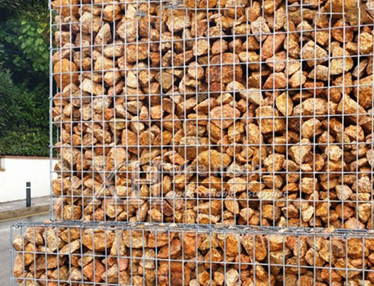Feb. 11, 2022
The word „gabion“ comes from an old Italian word, gabbione, which means „big cage“. Around 7000 years ago, early gabion-type structures protected the bank of the river Nile. In the middle ages, gabions were used as military forts. In earlier history, civil engineers have extensively used gabions for the stabilization of banks, coasts, highways, and erosion control of slopes. From the banks of the River Nile, where they were created up to today, gabion walls are a benefit for the landscape. It is used for thousands of years as a gravity-type retaining structure and makes an attractive, efficient, and cheap wall system.
Gabion walls are executed mainly for the purpose of soil stabilization behind the wall, but they can also be executed as a cover wall. The wall is made from gabion baskets that are stacked in one or more rows, depending on the height of the wall. Baskets have a cage shape and are closed on all sides. They are made from galvanized hexagonal meshes and broken rock that are placed in the baskets. Retaining structures are formed by stacking gabion baskets in a proper schedule and presenting an alternative solution for concrete structures in the area of soil stabilization.
Hexagonal Gabion Box
Gabion walls have an application mostly in road engineering, e.g. construction of roads, embankments, retaining walls, slope protection, water barriers, etc., and can have different functions:
• creation of a barrier that prevents soil erosion in coast and embankment stabilization
• prevention of sliding and washouts
• water speed reduction in the prevention of soil erosion in waterways
• noise protection
• aesthetic fence structures for gardens

Welded Gabions
• Aesthetic – gabion walls look natural and by using natural materials fits into the environment
• Compatibility with the environment – using the material made by excavations the costs of acquisition and transport are significantly reduced
• Is used as a cooling system in hot climate conditions and provides passive cooling by air movement
• Water permeability – gabion walls are permeable and are not damaged by passing water
• Efficiency of gabion walls can increase in the time since the vegetation fills voids and strengthens the wall structure
• Soil movements don’t negatively influence gabion walls, which is an advantage in regard to stiffer structures (reinforced concrete walls)
• Longevity – stone blocks are materials that are frequently used because of their longevity, durability, and stability. Usually, the stone is selected because of aesthetic attributes or the possibility of excavation-produced material usage.
Common gabion basket dimensions are 2,0 x 1,0 x 1,0 m. Galvanized mesh has a hexagonal shape with the eye size X x Y = 8,0 x 10,0 cm.
After the baskets are stacked they are connected with galvanized wire to prevent deformation under the weight of upper gabion rows.
Brocken rocks that are used as a fill have to be from natural stone resistant to atmospheric influence. Rocks are placed in the vicinity of gabion baskets and are machine or hand placed. After filling, baskets are closed and connections on meshes are attached with galvanized steel rings.
Gabion baskets are folded when transported to the construction site in order to take up as little space as possible. After transport, baskets are unfolded, connected, and prepared for positioning.
Previous: Type of Slope Protection Nets
Next: Types of Wire Mesh